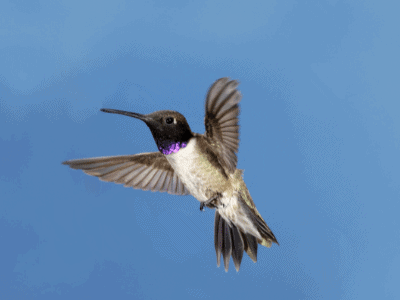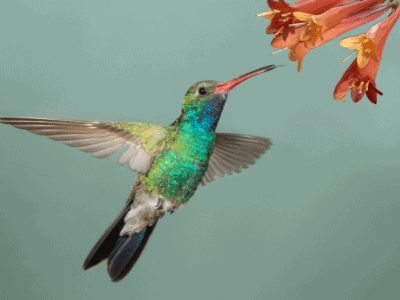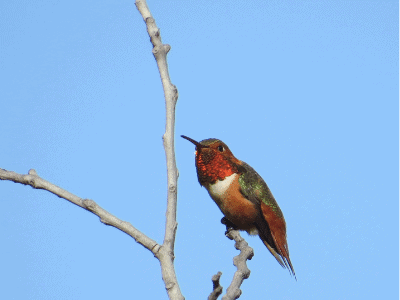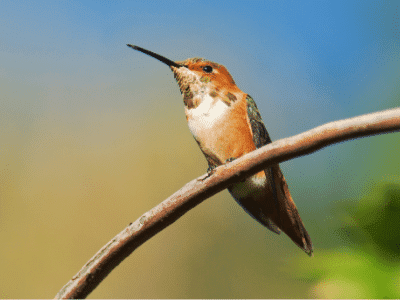In a large part of North America, hummingbirds are summer visitors that retreat to the tropics in the winter.
But in much of the southern tier of states of the USA, hummingbirds are backyard visitors all year round.
Hummingbirds Migration System
Depending on where you live in North America, you may see the same hummingbirds:
- In summer, during their breeding season,
- In the spring and fall, as they migrate north to their breeding locations or south to winter shelter,
- In the winter, as they take shelter in your backyard, or
- All year round, in a few locations in the US Southwest and along the Pacific Coast of the US and Canada.
One of the peculiarities of hummingbird migration is that the farther south you live, the sooner hummingbirds will leave for their winter homes in the fall.
Hummingbirds have developed a system in which the birds that have the longest way to travel get the last flowers of the season.
If you live in the South or Southwest, “your” hummingbirds may leave in the summer, but migrating hummingbirds may stop by as late as early fall.
Knowing when you can expect hummingbirds to arrive in your landscape and how long you can expect them to stay gives you additional opportunities to keep them in your backyard.
More and more hummingbirds are giving up migratory habits and staying in backyards where feeders are filled all year round.
We will have more to say about those species of year-round hummingbirds later in this article.
Most North American Hummingbirds Fly South for the Winter
Of the 15 species of hummingbirds seen in the United States and Canada, 13 normally fly south for the winter.
The other two can fly south, but have mostly managed to find year-round homes around backyard hummingbird feeders in California and the Southwest.
There are two more than sometimes choose to spend winters and summers in the same place.
There are also two kinds of hummingbirds we’ll describe later that sometimes decide to spend the winter halfway to their usual winter homes, in Texas or Florida.
Also read: How Do Hummingbirds Survive the Winter?
Black-Chinned Hummingbirds
Black-Chinned Hummingbirds are seen in all kinds of terrain across the western United States.

They are at home in deserts, in the mountains, in suburban backyards, and in city parks.
The easiest way to recognize Black-Chinned Hummingbirds is by listening to them. Male Black-Chinned Hummingbirds make a whining sound as they fly.
Both male and female Black-Chinned Hummingbirds have a strip of purple on their necks that is visible only when the light hits it just right.
Black-Chinned Hummingbirds breed in locations stretching all the way from southeastern Alaska and British Columbia to Texas, but they fly south to Mexico to spend the winter.
Broad-Billed Hummingbirds
Broad-Billed Hummingbirds are beautiful birds in a beautiful family.

The male’s bright red bill, glittering sapphire coast, and emerald body are more colorful than any other hummingbird commonly seen in the US and Canada.
The beautiful birds seek out flower-filled canyons and backyard hummingbird feeders in southwestern New Mexico and in Arizona to the south and east of Tucson. They spend most of their time in western Mexico, east of the Gulf of California.
Broad Tailed Hummingbirds
Broad-Tailed Hummingbirds breed in the Rocky Mountains and Great Basin where temperatures often fall below freezing at night, even in the summer.
They survive the night by going into a state called torpor, in which their metabolisms shut down and their heart rate slows down greatly.
Then when the sun comes out the next morning, they become frantically active seeking food.
Male Broad-Tailed Hummingbirds have rose-magenta throats They attract females for mating by doing spectacular dives.

Then when mating is accomplished they leave the females to build their nests and take care of their chicks on their own.
Broad-Tailed Hummingbirds migrate through eastern Colorado and New Mexico and the Texas Panhandle to their winter homes in Mexico.
Buff-Bellied Hummingbird
Buff-Bellied Hummingbirds aren’t very common outside the immediate Gulf Coast, but they are easy to recognize.

They have a pronounced buff-colored belly when viewed from the side. Adults of both sexes have buff-colored breasts and olive green feathers on their backs.
Male Buff-Bellied Hummingbirds have red bills with a dark tip. The female’s bill is less colorful.
Buff-Bellied Hummingbirds are unusually long-lived. The Texas Department of Parks and Wildlife tagged a Bull-Bellied Hummingbird that lived to be at least 11 years old.
Buff-Bellied Hummingbirds are the only hummingbird that flies north after breeding in the summer.
Some Buff-bellied Hummingbirds fly from their breeding grounds in South Texas to the Coastal Bend area of Texas near Houston and coastal Louisiana.
Others follow the Gulf Coast east to Florida to spend the winter, or decide to live year-round on the Gulf Coast of Mexico.
Calliope Hummingbird
The Calliope Hummingbird is the smallest bird in North America.

The males have magenta rays extending down their necks and wear green vests. Immature Calliope Hummingbirds and females have a bronze-green back and peachy underparts.
These tiny birds breed in the Canadian Rockies and the Cascades of Oregon and Washington state.
They fly through California and the American Southwest, sometimes as far east as West Texas, on their way to their winter homes in southwestern Mexico.
Costa Hummingbird
Costa’s Hummingbirds are uniquely adapted to life in the Mojave Desert.

They thrive in the blazing desert heat during the day, but they are known to enter a state of near-hibernation on cool nights.
Their hearts normally beat at a rate of 500 to 900 beats per minute, but may slow down to just 50 beats a minute to conserve energy when flower nectar is not available.
Male Costa’s Hummingbirds have bright purple feathers. Their feathers hang down from their faces like a mustache
Female Costa’s hummingbirds are dressed in green, with a pale eyebrow and a white belly.
The male Costa’s Hummingbird woos its mate by dancing in a U-shaped pattern around the female while making a high-pitched whistle.
These hummingbirds make their summer home in the blazing heat of the Mojave Desert.
Costa’s Hummingbirds sometimes choose to live year-round in coastal California. Or they may take a winter break around Acapulco in Mexico.
Lucifer Hummingbird
Lucifer Hummingbirds are highly sought-after by birdwatchers.

These tiny hummingbirds have vividly purple feathers on their throats and forked tails, giving them their name.
They sometimes build their nests in the desolate, rocky desert of southwestern New Mexico or Big Bend National Park in Texas.
Lucifer Hummingbirds spend the winter in southwestern Mexico. They may live year-round in the mountains north of Mexico City.
Rivoli’s Hummingbird
Rivoli’s Hummingbirds are large, dark hummingbirds that were once known as “Magnificents.” They have purple crowns and emerald throats.

Because of their size, Rivoli’s Hummingbirds don’t need to push other hummingbirds around.
They travel in a trapline from flower to flower, choosing the flowers they want. They aren’t pushy at feeders, either.
You aren’t likely to see Rivoli’s Hummingbirds anywhere in the United States except in extreme southeastern Arizona, extreme southwestern New Mexico, or Big Bend National Park in Texas.
They may occasionally breed in the United States, but for the most part, they spend their time in central Mexico.
Also read: How to Keep Hummingbird Feeders from Freezing?
Not All North American Hummingbirds Migrate
Some of the most beloved species of hummingbirds will make permanent homes at backyard feeders that are filled without fail every day of the year.
Allen’s Hummingbirds are stocky, short, small hummingbirds that are about the size of a sparrow.

The males have a coppery tail, eye patch, and belly, contrasting a bronze-green back. Immature Allen’s Hummingbirds and females are bronze-green at the neck and head and coppery along the sides.
Both males and females have straight bills that are about as long as the head.
Male Allen’s Hummingbirds make a bumblebee-like sound to attract females to mate.
Two males may perform acrobatics side by side, diving at high speed and pulling up at the last microsecond to impress the female with their power.
Allen’s Hummingbirds are native to a narrow strip of the US Pacific coast from Santa Barbara up to southwestern Oregon.
They will make their homes around backyard feeders that are stocked all year in Los Angeles and Riverside counties in California.
Anna’s Hummingbirds are uniquely comfortable living in backyards. They are a little larger than Allen’s Hummingbirds, about the size of a sparrow.

The males have a rose-pink head, and the females have green above, gray below, pale red spots on their backs, and a line over their eyes.
You can recognize Anna’s Hummingbirds by their broad tail feathers. When they are perched, their tail feathers extend out as far as their wings.
Anna’s Hummingbirds have extended their range by learning to feed on exotic plants in backyard landscapes.
Originally limited to southern California, they now appear year-round from British Columbia to West Texas in locations where nectar and insects are reliably available.
Ruby-Throated Hummingbirds are the only hummingbird that builds their nests in the summer across most of the eastern half of North America.

They flash red and green in the sunlight as they dart from flower to flower to feed their young and then to build up fat reserves from migration.
Ruby-Throated Hummingbirds aren’t particularly territorial. Some backyard bird watchers have yards full of these birds when flowers are in full bloom.
Many Ruby-Throated Hummingbirds fly 600 miles (1000 km) across the Gulf of Mexico with no place to stop and rest. (Some Ruby-Throated Hummingbirds, however, land on the decks of oil rigs and passing ships.)
Even birds that spend the summer in Florida may brave the long flight over water to spend the winter in a more reliably warm winter climate.
But sometimes Ruby-Throated Hummingbirds find a nice backyard in Texas or Florida and decide to spend the winter there.
It’s hard to miss a Rufous Hummingbird. The males are bright orange on their backs and bellies. The male has an iridescent red throat.

Female and immature Rufous Hummingbirds are greenish with rusty coloration on their flanks. Both sexes have tail feathers that come to a point.
Rufous Hummingbirds are extremely territorial. They will chase other birds away from flowers even if they are just passing through on their migration path. They love to raid spider webs for trapped insects.
Rufous Hummingbirds are famous for making their summer homes in Alaska and spending the winter on the Yucatán peninsula in southeastern Mexico.
However, some Rufous Hummingbirds find a nice backyard in South Texas, sometimes as far north as Austin and Houston, and spend the winter there.
This decision can be disastrous for the bird, as it was during the extended record cold weather in February 2021, but sometimes warm winter weather permits Rufous hummingbirds to raise a third or even fourth brood of babies in their winter home.
Ornithologists have also identified three kinds of hummingbirds in northeastern Brazil that don’t migrate with the seasons.
Glittering-Bellied Emerald Hummingbirds, Stripe-Throated Starthroat Hummingbirds, and Blue-Crested Swallowtail Hummingbirds are happy to feed on tropical flowers all year long — although you will never see these species in your backyard in North America.
What to Do When Hummingbirds Won’t Leave
It’s natural for Allen’s and Anna’s Hummingbirds to make a winter home next to a feeder.
It’s not normal for Rufous and Ruby-Throated Hummingbirds to skip their migration to stay in a backyard. It is dangerous for them to risk the cold weather.
It is important to remember that the bird makes its own decision about whether it wants to migrate south for the winter.
You aren’t harming it by feeding it. You are helping it survive its decision to stay in your yard.
The best thing for backyard bird watchers to do when hummingbirds choose to stay in their backyards is to continue feeding them.
Rufous and Ruby-Throated Hummingbirds don’t get a cue from other birds that it is time to migrate.
Scientists believe that these hummingbirds respond to their own internal biological clocks, activated by changing the length of daylight as the days get shorter in the fall and longer in the spring.
Sometimes a Rufous or Ruby-Throated Hummingbird’s internal calendar just doesn’t work.
Other kinds of North American hummingbirds reliably migrate to warmer locations for the winter.
The best ways to attract these hummingbirds to your backyard depend on whether you are providing a breeding ground, a migration station, or a winter retreat.
What to Do for Year-Round Hummingbirds
Hummingbirds seek different resources at different times of the year.
When hummingbirds fly in from their long spring or fall migration, they need to refresh themselves with nectar or sugar water.
When hummingbirds are mating, they need undisturbed places to build their nests and nest-building materials.
When hummingbirds are raising their young, they need a steady supply of small insects to feed their babies.
When hummingbirds face a winter cold snap, they need secure places to go into a state of torpor where they won’t be found by predators.
Hummingbirds that find resources can live long lives. Provide the best habitat you can, and don’t take down the hummingbird feeder until every hummingbird is gone.
Other articles you may also like:
- Do Hummingbirds Attack Each Other?
- 10 Ways to Keep Woodpeckers Away from Hummingbird Feeder
- Do Hummingbirds Like People?
- Can I Make Hummingbird Food with Brown Sugar?
- Why Have Hummingbirds Stopped Coming to the Feeder?
- Do Birds Use Birdhouses in the Winter?
- What Do Hummingbirds Eat?
- Where Do Seagulls Go At Night?

